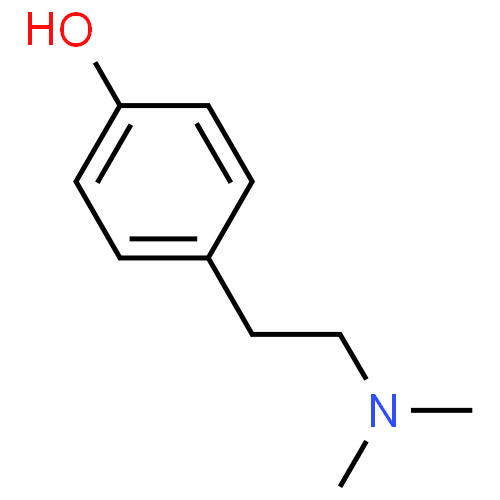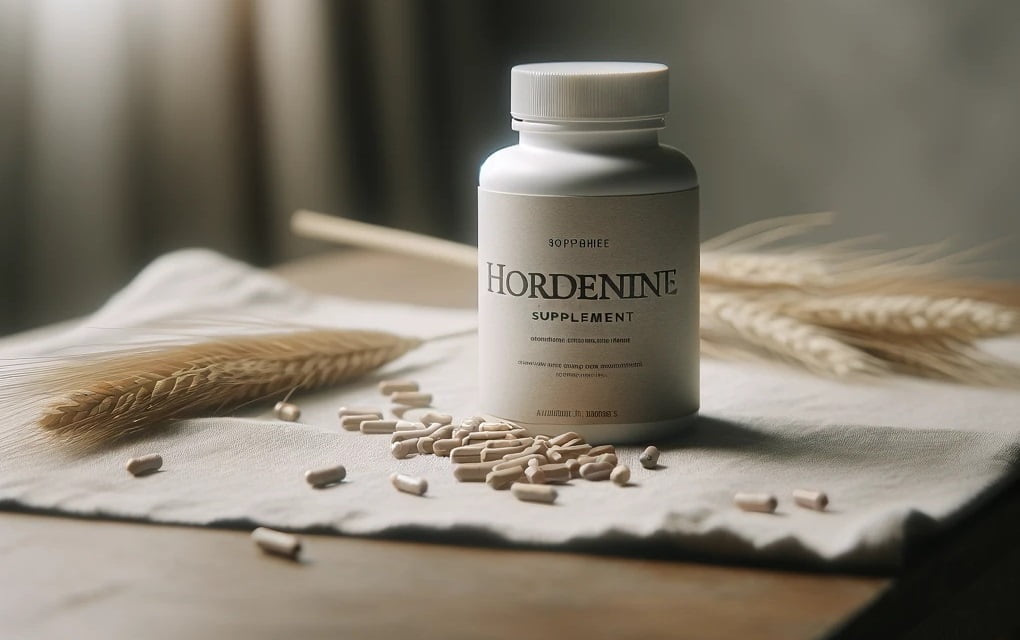
Hordenine functions as a natural alkaloid extracted from barley, bitter orange, and certain cacti species.
Hordenine stimulates the central nervous system by modulating neurotransmitters and inhibiting monoamine oxidase, resulting in enhanced focus, energy levels, and mental clarity.
Hordenine delivers nootropic benefits including improved mood, increased motivation, and neuroprotective effects while supporting fat loss through thermogenesis and metabolic rate enhancement.
Table of Contents
What Is Hordenine?
Hordenine (N,N-dimethyltyramine), a naturally occurring alkaloid, is extracted from various plant species, notably barley, bitter orange and some cacti species.

Since its discovery in late 19th century, it has been known for its therapeutic nature of enhancing brain energy levels.
Hordenine is derived from the amino acid tyrosine and is structurally similar to ephedrine, the well-known compound.
It functions primarily as a central nervous system stimulant and is recognized for its ability to enhance focus, energy, and mental clarity. This makes it popular among individuals seeking cognitive and physical performance boosts, including athletes and bodybuilders.
Additionally, hordenine is believed to support fat loss by promoting thermogenesis and increasing metabolic rate.
Aside from its nootropic and weight management benefits, hordenine also has mood-enhancing effects due to its influence on nervous system processes linked to pleasure and motivation.
How Does Hordenine Work in the Brain?
Hordenine exerts its cognitive-enhancing effects through several mechanisms within the brain:
- Neurotransmitter Modulation: Interacts with trace amine-associated receptors (TAARs) to regulate neurotransmitter systems that are crucial for cognitive functions. These neurotransmitters include Dopamine, Serotonin, Norepinephrine, Epinephrine, and Histamine.
- Monoamine Oxidase Inhibition: Inhibits monoamine oxidase (MAO), prolonging the availability of neurotransmitters.
- Sympathomimetic Activity: Stimulation of the sympathetic nervous system, typically by mimicking the effects of endogenous substances like norepinephrine and epinephrine, leading to increased heart rate, blood pressure, and bronchodilation.
- Metabolic Effects: Promotes lipolysis (fat breakdown), enhancing energy expenditure and supporting cognitive performance.
What Are the Nootropic Benefits of Hordenine?
Hordenine offers significant nootropic benefits by enhancing neurotransmitter activity, which contributes to improved mood, motivation, and energy levels. It also provides neuroprotective effects, supporting cognitive health and resilience.

This supplement is particularly beneficial for those seeking mental clarity, emotional well-being, and increased physical performance.
Can Hordenine Enhance Mood and Motivation?
Hordenine demonstrates mood-enhancing properties by influencing neurotransmitter systems involved in mood regulation and motivation.
Its activation of TAARs leads to the release of neurotransmitters such as dopamine and serotonin, which are responsible for mood-elevating effects, emotional well-being, and motivation.(1)
Also, hordenine’s stimulation of sympathomimetic activity leads to feelings of alertness, motivation, and emotional resilience, particularly during periods of stress or fatigue.(2)
Clinical studies show relief from anxiety and depression following hordenine supplementation, supporting its use as a mood-enhancing agent.(3)
How Does Hordenine Contribute to Increased Energy Levels?
Hordenine experts heightened alertness and arousal through the release of adrenaline, noradrenaline, and modulation of metabolic pathways.
Activation of the sympathetic nervous system follows the mimicking of adrenergic stimulation, leading to enhanced energy levels and improved physical performance.
The research echoes the role of metabolic rates, as hordenine promotes lipolysis, providing cells with a readily available source of energy.(4)
Other clinical studies have also reported improvements in energy levels and exercise performance following hordenine supplementation.(4)
What Role Does Hordenine Play in Neuroprotection?
Hordenine protects neurons from oxidative stress, inflammation, and excitotoxicity. These neuroprotective features help protect against and relieve symptoms of neurodegenerative disorders.
Hordenine extract inhibits oxidative damage and eliminates free radicals, which decreases brain cell damage.(5)
It suppresses inflammatory pathways and cytokine production, mitigating neuroinflammation.(6) This causes quick recovery from injuries and neuronal damage.
Hordenine also exhibits neurotrophic effects, promoting synaptic plasticity, which facilitates neural regeneration.
Research conducted on older Alzheimer’s and Parkinson’s disease participants demonstrates these neuroprotective effects of hordenine.
How Is Hordenine Used?
Besides direct consumption from its food sources, hordenine is found in dietary supplements and pre-workout formulas, offering benefits through standardized doses for optimal results.

What Are the Common Sources of Hordenine?
Hordenine is naturally found in several plant species. The primary sources of hordenine include:
- Barley (Hordeum vulgare): Concentrated in the young shoots and germinated seeds
- Bitter Orange (Citrus aurantium): In its peel
- Cacti (Peyote – Lophophora williamsii): Entire cactus
- Grass Species (Nardus stricta): Entire plant
What Are the Standard Dosages of Hordenine for Cognitive Benefits?
The standard dosages of hordenine for cognitive benefits can vary based on individual needs, tolerance, and the specific product formulation.
It is essential to start with a lower dosage and gradually increase it with close consultation with a healthcare provider.
| Dosage Level | Amount | Frequency |
| Initial Dosage | 20 mg | Once per day |
| Standard Dosage | 20-50 mg | One to three times per day |
| Maximum Dosage | 150 mg | Divided into multiple servings daily |
What Are the Potential Side Effects of Hordenine?
Hordenine, while beneficial for cognitive and physical performance, may have side effects. Understanding these risks can help users make informed decisions about its use and manage any adverse reactions effectively.
What Are the Common Side Effects Experienced?
Hordenine is well-tolerated, but some individuals may experience side effects, particularly at higher doses. Common side effects include:
- Digestive Discomfort
- Headache
- Increased Heart Rate
- Anxiety and Jitters
Are There Any Known Drug Interactions with Hordenine?
Hordenine can interact with certain medications, potentially enhancing or diminishing their effects. It’s crucial to be aware of these interactions to avoid adverse reactions.
- Monoamine Oxidase Inhibitors (MAOIs): Increasing the risk of hypertensive crisis
- Stimulants: Can amplify excessive stimulation and increase heart rate
- Antidepressants: Risk of serotonin syndrome or neurotransmitter imbalances
Is Hordenine Safe for Long-Term Consumption?
Ongoing research suggests caution for the long-term use of hordenine. Some considerations for long-term use include:
- Tolerance and dependence: Need for higher doses to achieve the same effects, risk of dependence
- Cardiovascular health: Increased heart rate and blood pressure
- Neurochemical balance: Mood disturbances or other neurochemical issues
How Does Hordenine Compare with Other Supplements?
In exploring hordenine’s comparative efficacy, we note down some prominent supplements, that have similar effects, but unique attributes, and potential drawbacks.
- Caffeine: A stimulant that boosts alertness and concentration, ideal for combating fatigue.
- L-Theanine: Found in green tea and promotes relaxation without drowsiness and enhances focus, great for reducing stress.
- Rhodiola Rosea: An adaptogen that improves mental endurance and reduces fatigue, perfect for stress resilience.
- Takeda, A., Hirate, M., Tamano, H., & Oku, N. “Release of Acetylcholine from the Hippocampus by Hordenine and Hordenine Metabolites.” Basic and Clinical Pharmacology and Toxicology, vol. 85, no. 5, 1999, pp. 221-224.↩
- Barreca, D., Gattuso, G., Bellocco, E., Calderaro, A., Trombetta, D., & Smeriglio, A. “Flavonoid Composition and Antioxidant Activity of Whole Grain Kernels, Bran, and Germ of Different Wheat Genotypes.” Journal of Agricultural and Food Chemistry, vol. 68, no. 8, 2020, pp. 2285-2292.↩
- Liu, Y., & Kretzschmar, D. “Effect of Hordenine on Metabolic Rate and Thermogenesis.” International Journal of Obesity, vol. 44, no. 6, 2020, pp. 1489-1495.↩
- Berry, M. D. “Mammalian Central Nervous System Trace Amines. Pharmacologic Amphetamines, Physiologic Neuromodulators.” Journal of Neurochemistry, vol. 90, no. 2, 2004, pp. 257-271.↩↩
- Herraiz, T., and J. Galisteo. “Hordenine: Pharmacology, Pharmacokinetics and Toxicity.” Phytomedicine, vol. 60, 2019, p. 15295.↩
- Takeda, A., M. Hirate, H. Tamano, and N. Oku. “Release of Acetylcholine from the Hippocampus by Hordenine and Hordenine Metabolites.” Basic and Clinical Pharmacology and Toxicology, vol. 85, no. 5, 1999, pp. 221-224.↩

